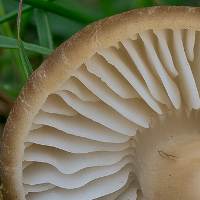Neohygrocybe ingrata (J.P. Jensen & F.H. Møller) Herink - Dingy Waxcap
Phylum: Basidiomycota - Class: Agaricomycetes - Order: Agaricales - Family: Hygrophoraceae
Distribution - Taxonomic History - Etymology - Identification - Culinary Notes - Reference Sources

Many of the waxcap mushroom species can be tricky to identify, but with its dry ochre buff or brown cap, often cracking at the margins, rusty-red-bruising gills, and dry slightly swollen stem, this faintly nitrous-scented waxcap is one of the more distinctive. Unfortunately, because of its rarity very few people get the opportunity to become familiar with the Dingy Waxcap.
Distribution
The Dingy Waxcap is a very rare find in Britain. In Ireland it has been found in County Wicklow. This species occurs also in some other European countries, but it is rare throughout this range.

Taxonomic history
The species was first described from the Faroe Islands in 1945 by J.P. Jensen & F.H. Møller.
The only recorded synonym I can find of Neohygrocybe ingrata is Hygrocybe ingrata J.P. Jensen & F.H. Møller. In 1958, Czech mycologist Josef Herink (1915-1999) proposed that this species differed sufficiently from others in the Hygrocybe genus to justify moving it to a new genus, Neohygrocybe. DNA analysis has since confirmed this distinction and so the generally accepeted name has become Neohygrocybe ingrata.
Etymology
The genus Hygrocybe is so named because fungi in this group are nearly always very moist (although Neohygrocybe species are among the few exceptions). The prefix Neo- means 'new, recent or modified', while -hygrocybe means 'watery head'. The specific epithet ingrata is a Latin adjective meaning 'unattractive'
Identification guide
 |
CapThe dry yellow-brown or ochre-brown to chestnut-brown cap, 20 to 60mm across, is initially convex, flattening unevenly with a central umbo and often cracking at the margins. |
 |
GillsCream to pale brown but usually much paler than the cap surface, the dry, broad gills are adnate-emarginate and moderately to quite widely spaced. When bruised, the gill edges turn a rust-red colour. |
 |
StemUpper stem concolorous with the cap or somewhat paler; lower stem usually a paler cream colour. Stems 3 to 10cm long and 5 to 20mm in diameter are dry and often flexuose; cylindric or laterally compressed and sometimes slightly swollen, tapering at the base. Flesh is white turning pale reddish brown when cut. |
SporesEllipsoidal, smooth, 7-9 x 5-6.5μm; inamyloid. Spore printWhite. |
|
Odour/taste |
Odour faintly nitrous; taste mild but not distinctive. |
Habitat & Ecological role |
In unimproved grassland where artificial fertilisers are not spread. Waxcaps have long been considered to be saprobic on the dead roots of grasses and other grassland plants, but it is now considered likely that there is some kind of mutual relationship between waxcaps and mosses. |
Season |
July to October in Britain and Ireland. |
Similar species |
Hygrocybe ovina (syn. Neohygrocybe ovina) has a dark sepia to blackish dry squamulose cap and very broad adnate gills. |
Culinary Notes
The Dingy Waxcap is rare and should not be collected other than for scientific study.
Reference Sources
Møller, Fungi of the Faeröes, Part I: Basidiomyceten: 136 (1945)
Neohygrocybe ingrata (J.L Jensen & F.H. Møller) J. Herink, 1959 (Index of Fungi 3: 85)
Fascinated by Fungi, 2nd Edition, Pat O'Reilly 2016, reprinted by Coch-y-bonddu Books in 2022.
Fungi of Northern Europe, Volume 1 - The Genus Hygrocybe, David Boertmann, 2010.
Dictionary of the Fungi; Paul M. Kirk, Paul F. Cannon, David W. Minter and J. A. Stalpers; CABI, 2008
Taxonomic history and synonym information on these pages is drawn from many sources but in particular from the British Mycological Society's GB Checklist of Fungi.
Acknowledgements
This page includes pictures kindly contributed by Tomas Milan.
Fascinated by Fungi. Back by popular demand, Pat O'Reilly's best-selling 450-page hardback book is available now. The latest second edition was republished with a sparkling new cover design in September 2022 by Coch-y-Bonddu Books. Full details and copies are available from the publisher's online bookshop...

